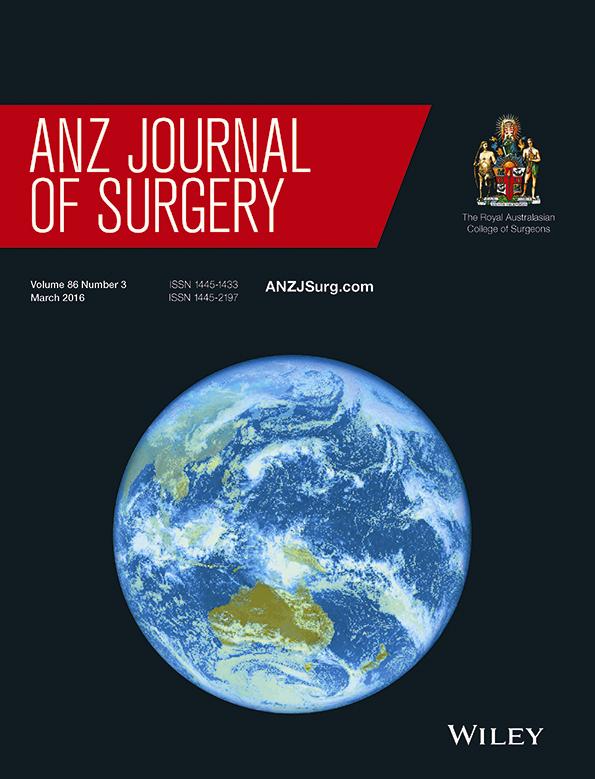The value of assessing post-operative mortality after oesophagectomy
In this edition of ANZ Journal of Surgery, Keong et al.1 report the Victorian statewide outcomes for post-operative mortality after oesophagectomy for the period 2011–2013. Over this 2-year period, 237 patients underwent oesophagectomy in 26 hospitals with a highly commendable post-operative mortality of 1.27%. No correlation between hospital volume and mortality was found.
Internationally, there has been an inconsistent approach to dealing with high risk surgery and centralization. Within Europe, regions such as the United Kingdom and the Netherlands have centralized oesophageal cancer resection with reported improvements in post-operative survival. The United States has not centralized care and while some high volume specialist centres report excellent outcomes, according to the SEER database, the system nationwide delivers very high 30-day mortality (8.9% in the years 2006–20092).
One of the challenges in determining the value of centralization of oesophagectomy procedures in the Australian system is the relative infrequency of the procedure, the large number of sites performing a low volume of cases and the fact that mortality is in fact now very rare. When reported in 1980, the post-operative mortality after oesophagectomy was 29%3 and it was a benchmark which had great scope for improvement. With centres now reporting post-operative mortality of 1–3%, it is now hard for differences in outcome to be seen as apparent. Considering the Victorian data, it would appear the majority of hospitals perform < 5 oesophagectomies/year and hence it would take a decade or more of data to observe any statistical outliers within the cohort. Similarly, with such low post-operative mortality and a lack of hospitals that are truly high volume (annual case load of >20 resections), a volume outcome relationship in Victoria will be difficult to find.
So are there other markers of quality of care that may prove more useful in the current environment in determining excellence in outcome? Cancer-specific survival is clearly important. In New South Wales,4 using six cases/annum as a definition of a ‘high volume’ hospital, no significant difference between high and low volume hospitals was found for in-hospital mortality post-oesophagectomy. However, there was a significant improvement in 5-year survival for those operated on in a high-volume centre, confirming that in-hospital mortality is not the only issue. Five-year survival outcome data requires excellent data linkage and necessitates a lag-time in reporting. It has been argued that 1-year survival provides a surrogate marker that incorporates both quality of surgical care and case selection.5 This may be an easier outcome for centres to report whilst still being a valid discriminator. For example, the Erasmus Medical Centre high-volume unit in Rotterdam recently reported a 30-day mortality of 2.7% and a 1-year survival of 71%, highlighting the impact of case selection and disease recurrence6 on longer term survival.
Surgical morbidity is inconsistently reported after oesophagectomy. As noted by Keong et al., failure to rescue may be more important than the actual complications in determining in-hospital mortality. However, complications do impact patients with consequent delays in return of quality of life post-oesophagectomy and they are associated with poorer long-term survival. A recent attempt has been made to standardize reporting of complications after oesophagectomy7 with the aim of allowing more valid comparisons of outcome between centres and to drive quality improvement. This approach to reporting post-operative complication should be adopted by those publishing outcomes and included if excellence is to be properly assessed.
In an environment where health funding is increasingly constrained, length of stay is a target for improvement. While the ANZGOSA upper gastrointestinal cancer audit (which includes surgeons voluntarily submitting data) confirms a mean length of stay after oesophagectomy of 18 days across Australia and New Zealand, the Health Round Table data for 2013–2014 revealed a range in average length of stay from 13 to 33 days in the 43 assessed hospitals. While there are potential differences between regions in discharge practices and locations, it does suggest great variation and the potential for improvement. In centres with a strong emphasis on early recovery after surgery, length of stay has been reduced from 17 to 7 days.8 Delivering this outcome required a dedicated team involving surgeons, anaesthetists, intensivists, physiotherapists, ward nurses and nurse specialists. It is difficult to build the experience, training and commitment of such a team in centres with very low case volumes.
Ultimately it is reassuring that oesophageal cancer resection is practised in Victoria with very low post-operative mortality. However, excellence should be defined by more than just mortality and future publications should include more comprehensive assessments of outcome if valid conclusions about outcomes are to be made.




